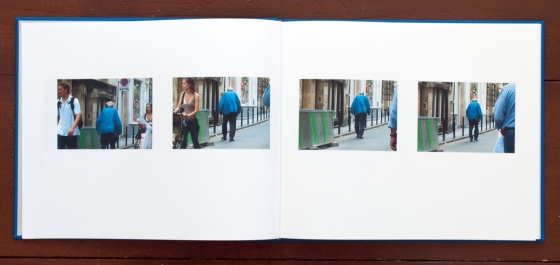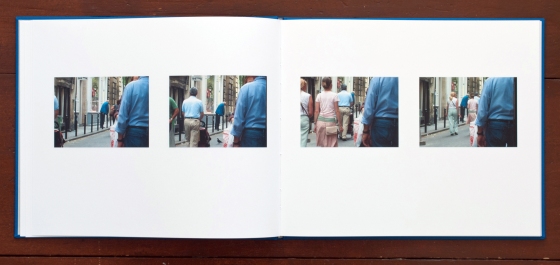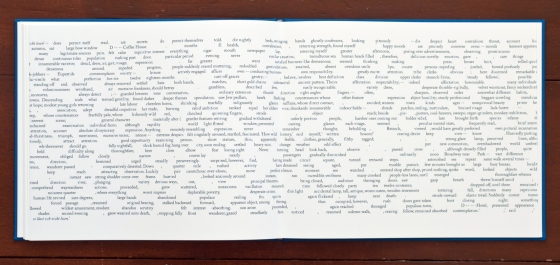The Man of the Crowd
The book is about observing and being observed in the urban crowd. It connects Edgar Allan Poe’s story ‘The Man of the Crowd’ to a chance occurrence photographed in a Parisian street. A series of 56 photographs shows an old man appearing and disappearing in a miscellaneous crowd of people drifting by. The photos are followed by experimental textworks that reprocess Poe’s story, exhibiting the story’s latent messages and providing intricate connections to the photoseries.
Published in Leerdam, The Netherlands, 2012. See more images of the book here.
Sewn, hardcover, linen with foilstamp. Full colour printing. 48 pages plus one foldout sheet. Size 23.5 x 19.5 cm / 9.25 x 7.7 inches. ISBN 978-90-807884-0-4.
The price of the book is €50. Order through email or my webshop.
This work is also available as an unbound artist book that is suitable for exhibition (edition of 14 copies).
The book is included in the collections of Bayerische Staatsbibliothek, Beinecke library, Bibliothèque Kandinsky (Centre Pompidou), Bodleian Library (special collections at Weston Library), Columbia University, Hasselblad Foundation, International Center of Photography Library (New York), John M. Flaxman Library at School of The Art Institute of Chicago (Joan Flasch collection), Kunstbibliothek (Berlin), Kunst- und Museumsbibliothek Köln (Museum Ludwig), MoMA Library, National Library of The Netherlands (Koninklijke Bibliotheek), Tate Library and Archive, The New York Public Library, University of Virginia Library, Zentralinstitut für Kunstgeschichte (Munich). See some more information about the book below.
The story
In 1840 Edgar Allan Poe’s ‘The Man of the Crowd’ was published, one of the first detective stories, though the crime remains hidden. It is a story about an observer-narrator ‘I’ who sits at a coffee house in London and develops a curiosity about a striking old man he sees in the crowded streets. He decides to follow the old man (he could very well be seen as a proto-street-photographer). He follows him for an evening, a night, a day, a second evening. The old man keeps on walking and never leaves the crowd. The observer has to conclude that the old man cannot be read and interpreted like the other people in the streets. The whole tale becomes a story about the unreadable.
The book
The book picks up the story and places it in Paris, where I saw the man of the crowd in a street around the corner from Place Saint-Sulpice. He stood still while the environment around him changed. He disappeared and reappeared while a mix of people drifted through the street. The scene was recorded with a simple point-and-shoot camera and every shot is included in the book. Two imagetexts follow the photoseries. The first is an analysis of instances of the word ‘I’ in Poe’s story, reworking the story into a new poem. The second is a crowded street of words on a long foldout sheet, showing Poe’s story in full while also indicating places that remain unreadable. Both texts were made by applying linguistic analysis tools (concordance software) to the original story. The book ends with notes on the project. Each book is marked with a distinct word from Poe’s story, which limits the edition to the number of different words in the tale.


